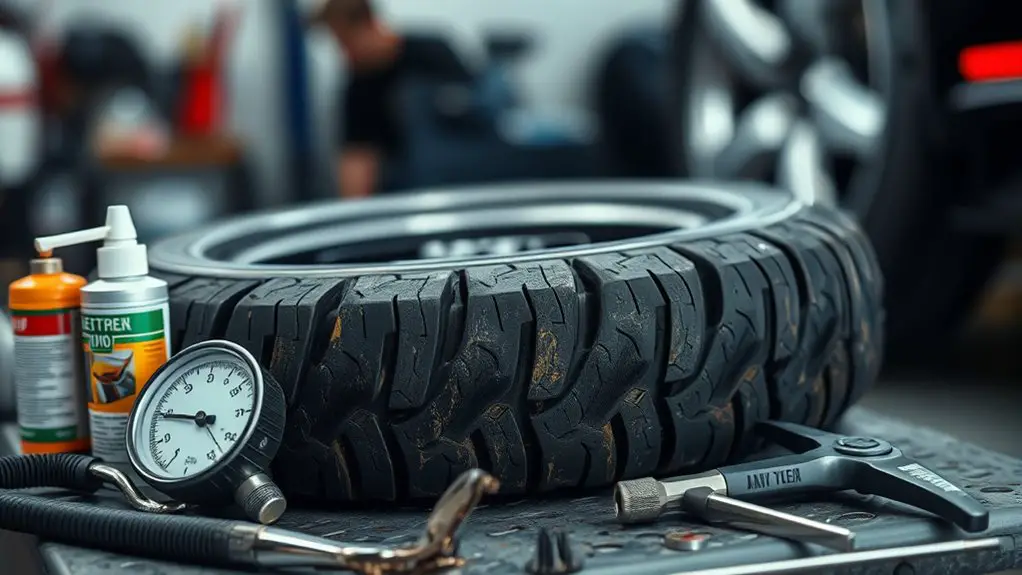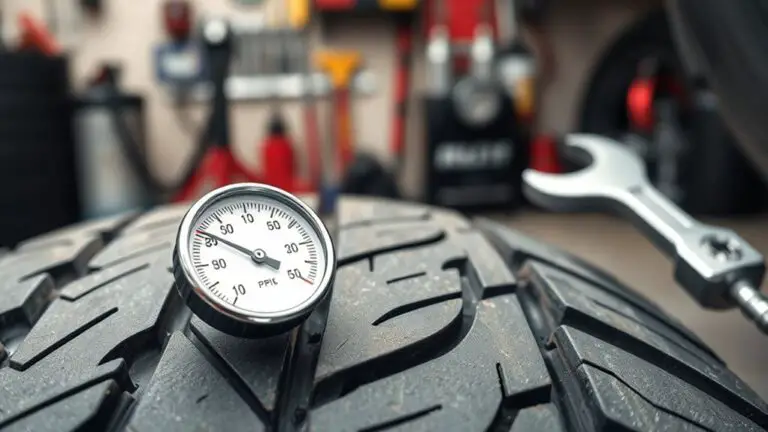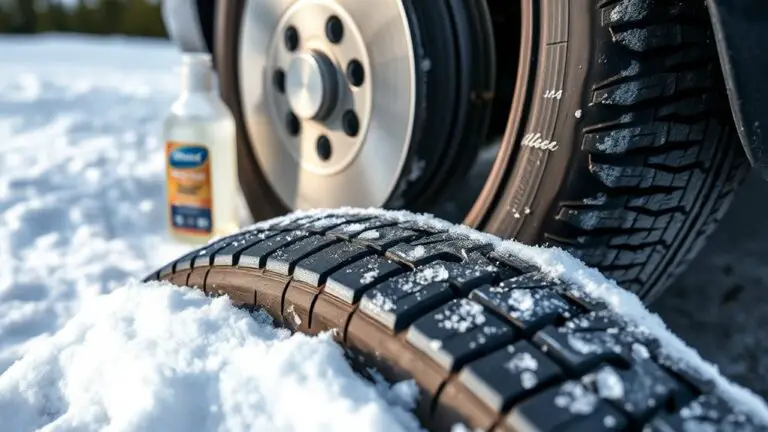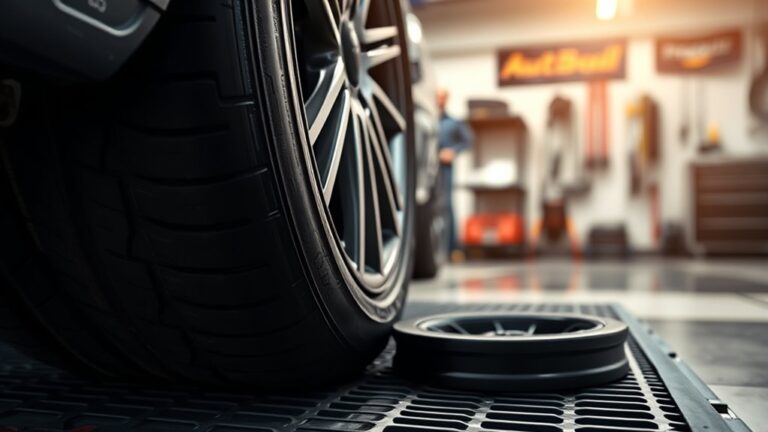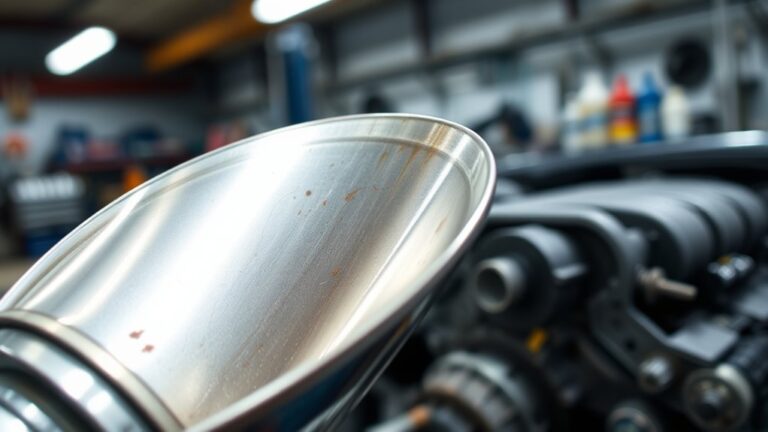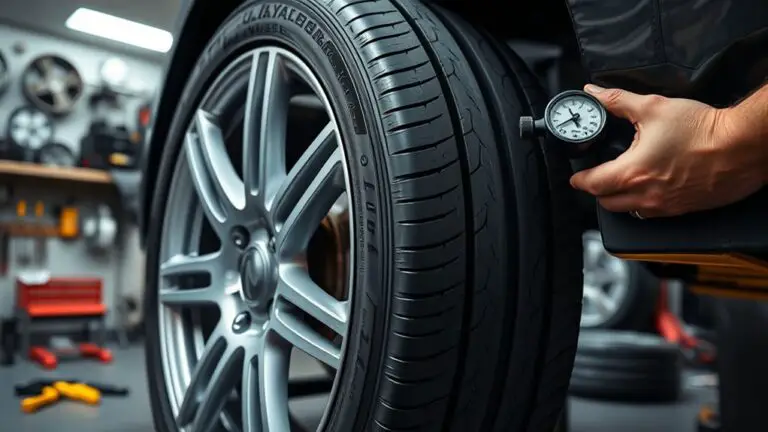Cost-Saving Maintenance to Prevent Common Tire Neglect
Keep your tires safer and cheaper by staying proactive. Regularly check pressure when tires are cold, using a reliable gauge, to prevent under- or overinflation and save fuel. Measure tread depth and monitor wear indicators to spot uneven wear early. Schedule rotations every 5,000–8,000 miles, and choose cost-effective tires with solid tread life and warranties. Pair this with smart driving—gentle acceleration, smoother braking—and proper seasonal storage. If you keep this up, you’ll reveal more money-saving tire tips.
Checking Tire Pressure Regularly
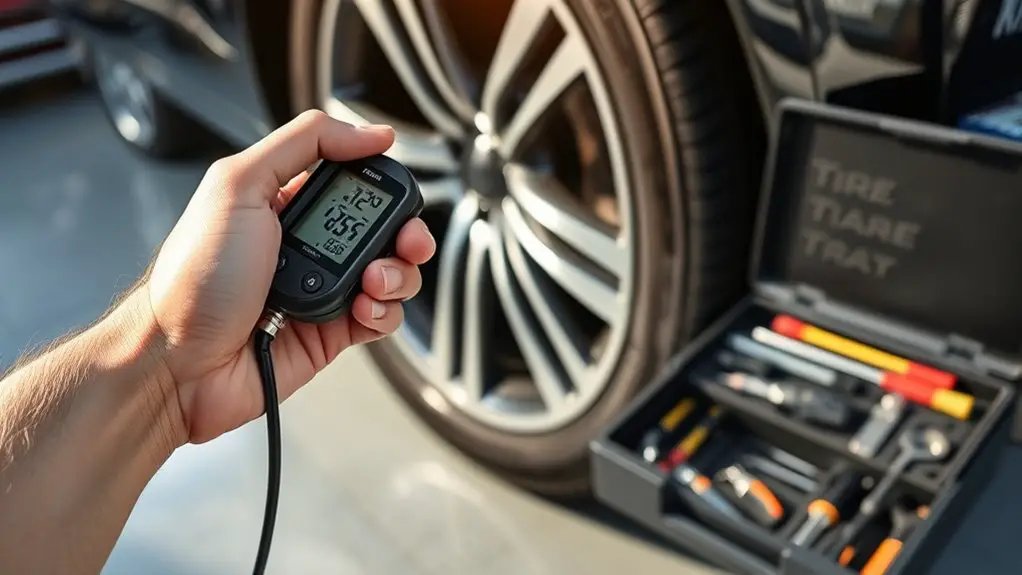
Checking tire pressure regularly is essential for safety and fuel efficiency; when you stay on top of it, you’ll notice improvements in handling and tire longevity. You’ll verify the current PSI on each tire using a reliable gauge, ideally when tires are cold. Underinflation wastes fuel and increases rolling resistance, while overinflation can reduce grip and cause uneven wear. Consistent checks help you catch slow leaks from nails, wheel damage, or valve stems before a flat forces downtime. Record the target pressure from your vehicle manual or door placard and compare it to your readings weekly or after long trips. Inflation benefits are clear: ideal pressure improves mileage, extends tire life, and stabilizes braking performance. Make this a quick, routine habit—pre-drive checks take minutes and empower you to maintain control. With disciplined tire care, you preserve freedom to travel farther, safer, and with fewer unexpected costs.
Understanding Tread Depth and Wear Indicators
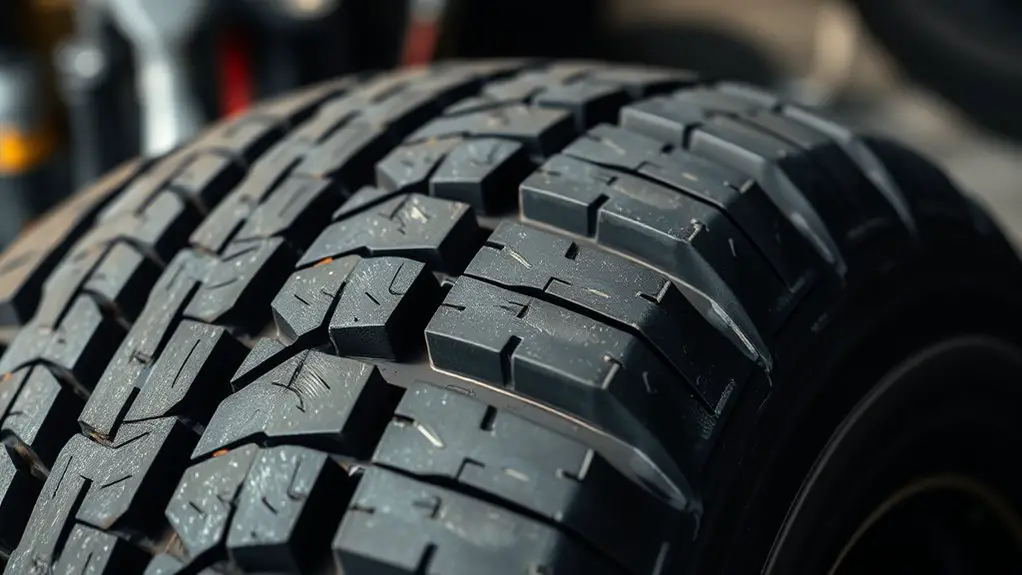
Tread depth and wear indicators are your early warning system for safe stopping distances and even tire performance. You’ll measure depth with a simple gauge or coin test, then compare to legal and manufacturer guidelines to decide when to replace. Practically, deeper tread means better grip in rain, snow, and heat, so you’re optimizing traction without overpaying for premature replacement. Look at tread patterns to spot irregular wear, which can signal alignment or suspension issues that waste gas and shorten tire life. Wear indicators—the small bars molded into grooves—rise to meet the tread surface as wear progresses; when they’re flush, you’re at the minimum safe depth. Track wear visually across all four corners and rotate as needed to promote even wear. Use this data to plan replacements, maximize mileage, and maintain predictable braking performance—without sacrificing your freedom to drive confidently.
Scheduling Timely Tire Rotations
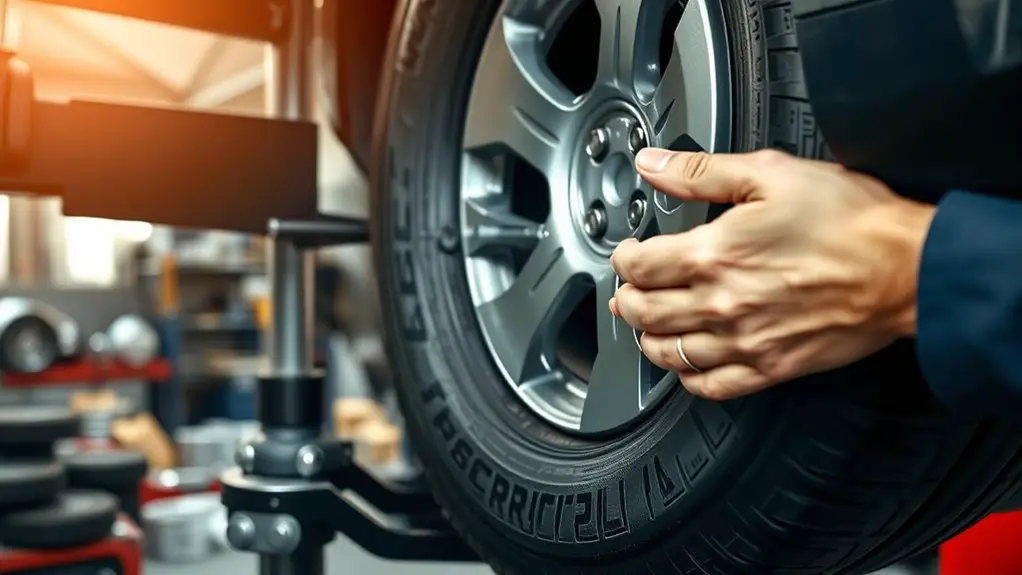
Rotations should be scheduled before uneven wear signs become pronounced, since even wear extends tire life and improves fuel economy. Check rotation timing guidelines and track patterns so you can adjust intervals as needed. If you notice irregular tread wear, use that data to justify sooner rotations and prevent costly early replacements.
Rotation Timing
To keep tires balanced and wear even, schedule rotation every 5,000 to 8,000 miles or as recommended in your vehicle’s manual, and adjust for conditions like heavy loads, aggressive driving, or all-wheel-drive systems. You’ll benefit from a clear rotation frequency linked to your driving style and terrain, not a one-size-fits-all timetable. Use rotation patterns that fit your setup—front-to-back on some cars, cross-pattern on others—to preserve tread depth evenly and minimize vibration. Track miles and date, updating cadence if you notice changes in handling. A simple log helps you stay proactive and avoid costly imbalances. Rotation timing matters: consistent intervals beat irregular lapses, keeping tires fresh and your ride smooth.
| Miles/Months | Pattern A | Pattern B |
|---|---|---|
| 5,000–8,000 mi | Front-to-back | Cross-pattern |
| 12,000–15,000 mi | Rear-to-front | Cross-pattern |
| 20,000–24,000 mi | Alternate diagonals | Front-to-back |
| 25,000+ mi | Assess condition | Adjust cadence |
Uneven Wear Signs
Uneven wear is a clear watchdog for your tire schedule—if you notice it, you’ll likely need to adjust rotation timing before the issue worsens. You’re after proactive, data-backed decisions, not guesswork, so watch wear patterns closely and map them to rotation intervals. Proper tire alignment helps you pull even life from each tire, reducing costly replacements. Track tread depth by position and compare across tires; if disparities widen, rotate sooner. When you see cupping, feathering, or heel-toe wear, treat it as a signal to reassess alignment and suspension as part of the plan.
- Monitor wear patterns weekly and log changes
- Align tires promptly if misalignment is detected
- Schedule rotations at data-driven intervals
- Confirm results with even tread depth across all tires
Choosing Cost-Effective Tire Options
When you’re choosing tires, weigh budget-friendly types against expected longevity and fuel efficiency to maximize value. Compare cost per mile, tread wear ratings, and warranty coverage to guide a value-driven selection. This approach keeps upfront price in check while prioritizing reliability and long-term savings.
Budget-Friendly Tire Types
Choosing budget-friendly tire types starts with matching price, performance, and mileage expectations to your driving needs; in other words, you’ll get the best value when you compare tire types by cost per mile, tread life, and fuel efficiency. You’ll find budget tires that don’t compromise tire performance if you look at labels, warranty, and seasonal suitability. Focus on load rating, speed rating, and expected wear to avoid early replacements. Align choices with your daily routes and climate to maximize value. With data-driven comparisons, you can stay fearless while saving cash and maintaining safety.
- Cost per mile versus initial price
- Tread life and warranty coverage
- Fuel efficiency impact
- Seasonal versus all-season suitability
Value-Driven Tire Selection
Growing value from tires starts with selecting options that balance upfront cost, long-term wear, and fuel use. You’ll compare tire performance across tread designs, constructions, and wear ratings to identify options that endure miles without draining your budget. Seek data-backed guidance on rolling resistance and fuel economy to forecast savings beyond the sticker price. When evaluating brands, rely on independent testing and warranty terms, not hype, to avoid overpaying for prestige. Consider all-season versus seasonal tires in your climate, and factor load index and speed rating for safety and efficiency. Use brand comparisons to spot consistently strong performers at reasonable prices, then align choices with your driving style and freedom goals. Prioritize durable tires that deliver steady performance and predictable maintenance costs.
Extending Life With Proper Driving Habits
Driving smoothly and avoiding aggressive behavior can greatly extend tire life and cut costs. You’ll influence wear patterns, traction, and fuel efficiency with deliberate driving techniques and steady inputs. Practice gradual acceleration, gentle braking, and consistent speeds to minimize tread flat-spotting and heat buildup. Prioritize smooth steering inputs and timely, predictable maneuvers to reduce tire scrub and sidewall stress. Regularly anticipate traffic, lane changes, and loading conditions to avoid abrupt loads that accelerate wear. Combine these habits with mindful routes to dodge rough pavement and potholes, which can compromise tire health. Within tire maintenance, you’ll notice measurable benefits in longevity and performance, supported by clear data on wear rates and energy use. Build a habit loop: plan trips, monitor tire pressure, rotate with maintenance checks, and refine your technique over time.
- Maintain steady speeds and gentle braking to reduce heat and wear
- Anticipate traffic to minimize abrupt steering and loading
- Rotate and inspect tires with routine maintenance checks
- Choose smoother routes to avoid rough pavement and potholes
Seasonal Care and Storage Tips
Seasonal tire care matters: temperatures, humidity, and road conditions shift how tires wear, so you should adjust maintenance and storage practices with the season. You’ll plan ahead by mapping temps and road exposure, then tailor checks accordingly. In cold months, verify tread depth, inflate to spec, and look for cracks or sidewall
Frequently Asked Questions
How Often Should a Tire Pressure Monitor Be Recalibrated?
A hypothetical fleet manager recalibrated their TPMS after every tire rotation, and their pressure accuracy stayed within ±1 psi for a year. Recalibrate the tire pressure monitor at least annually, or sooner if you notice abnormal readings, sensor malfunctions, or after tire work. The practice supports tire maintenance and keeps pressure accuracy reliable. Stay proactive: check readings against a manual gauge monthly, and log results to guide maintenance decisions for freedom and safety.
Do Cheap Tires Wear Faster in Urban Driving?
Yes, cheap tires can wear faster in urban driving. You’ll see reduced tire performance as you contend with stop-and-go traffic, potholes, and curb impacts. Your tire longevity hinges on your driving habits, maintenance, and road quality in urban conditions. To maximize life, monitor pressures, rotate regularly, and choose tires designed for city use. By staying proactive, you protect performance and save money while enjoying freer, more confident driving.
Can Tire Sealants Be a Cost-Effective Option Long-Term?
Yes, tire sealants can be cost-effective long-term if you drive low-to-moderate puncture risk and apply as directed. You’ll notice tire sealant effectiveness in preventing flats and sealing small leaks, reducing downtime. Over time, the savings from fewer tire repairs or replacements can add up, but results vary by road conditions and tire type. Track costs, balance performance, and consider your driving habits to gauge long term savings for your situation.
Will DIY Tire Repairs Affect Resale Value?
DIY repairs can affect resale value, but done right, the impact is manageable. You’ll boost resale perception by documenting quality fixes, using proper materials, and keeping tire aesthetics clean. Prioritize safe, permanent fixes over quick patches, and track maintenance investment to show buyers you care about longevity. Be ready with receipts and photos. When you lead with transparency and durability, you preserve value while maintaining your freedom to drive without compromise.
Do Run-Flat Tires Save Money on Maintenance Costs?
Yes, run-flat tires can save you money on maintenance costs, especially if you value uninterrupted mobility. You’ll avoid roadside tire changes and tow fees, thanks to built-in support. Yet, beware higher upfront costs and potentially stiffer ride. Consider run flat benefits like reduced littering of roadside stops and fewer emergency repairs. Over time, maintenance savings accumulate, but weigh tire life and fuel impact. Stay proactive, compare tread life, and choose option that fits your freedom-minded budget.

